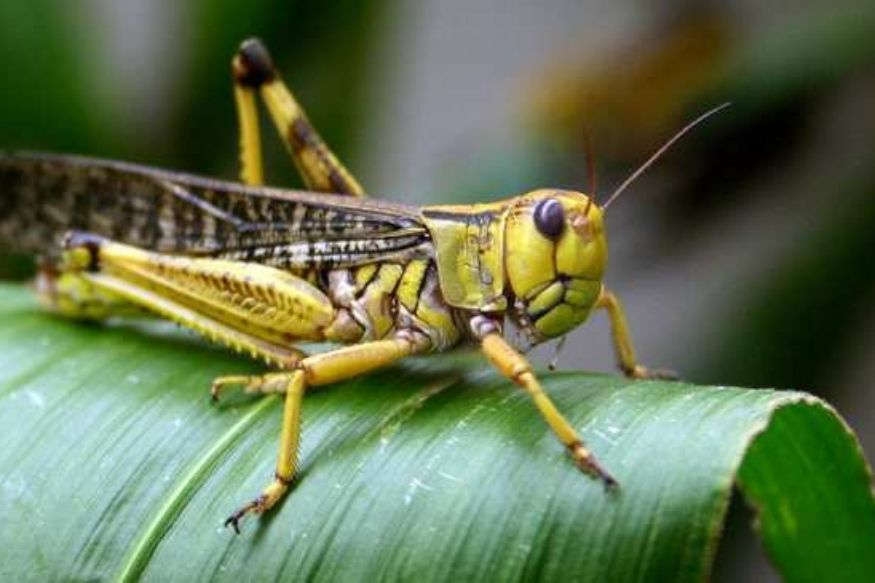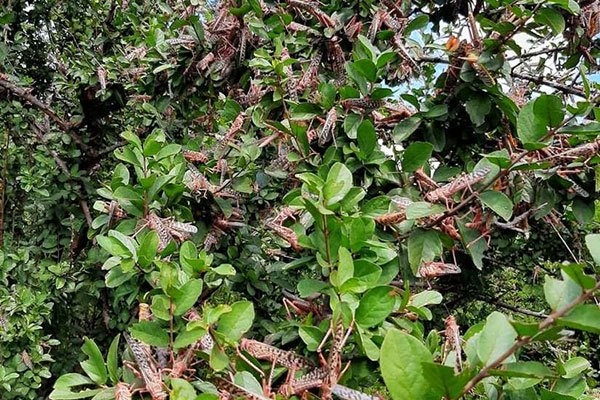Rajasthan and Gujarat worst hit by locust attack: Know here science and geography of the menace
Total Views |
Jaipur, January 15: North-western states, especially Rajasthan and Gujarat are facing biggest locust attack in the last 60 years. In Rajasthan, Kharif and Rabi crops in the area of around 3.60 lakh hectare have been severely affected so far. Farmers in the states, already hard hit by drought, are worst hit by this menace.

What is locust attack?
Locust attack is the attack on crops by insects called as locusts which are locally known as Tiddis. Locusts are a collection of certain species of short-horned grasshoppers in the family Acrididae that have a swarming phase. These insects are usually solitary, but under certain circumstances they become more abundant and change their behaviour and habits, becoming gregarious.
Under suitable conditions of drought followed by rapid vegetation growth, serotonin in their brains triggers a dramatic set of changes: they start to breed abundantly, becoming gregarious and migratory when their populations become dense enough.
Locusts cause great devastation to natural and cultivated vegetation. They are indeed the sleeping giants that can flare up any time to inflict heavy damage to the crops leading to national emergency of food and fodder. On an average small locust swarm eats as much food in one day as about 10 elephants, 25 camels or 2500 people!
Havoc by locusts in India:
Out of the ten important species, Four species viz. Desert locust (Schistocerca gregaria), Migratory locust (Locusta migratoria), Bombay Locust (Nomadacris succincta) and Tree locust (Anacridium sp.) are found in India. The desert locust is most important pest species in India as well as in intercontinental context.
Historically, the Desert Locust has always been a major threat to man’s well-being. India witnessed several locust plague and locust upsurges and incursions during last two centuries. Small scale localized locust breeding have also been reported and controlled during the period 1998, 2002, 2005 , 2007 and 2010. Since 2010 till 2012-13, situation remained calm and no large scale breeding and swarms have been reported. However, solitary phase of Desert locust has been reported from time to time at some locations in the State of Rajasthan and Gujarat.

As per a government report, In our country, in spite of taking control measures, damage to crops caused by locusts during 1926-31 cycles, on a conservative estimate, was about Rupees 10 crore. During 1940-46 and 1949-55 locusts cycles the damage was estimated at Rs. 2.00 crore each and it was only Rs. 50.00 lakh during the last locust cycle (1959-62). Although no locust plague cycles have been observed after 1962, however, during 1978 and 1993, large scale upsurges were reported. Damage estimated was Rs. 2.00 lakh in 1978 and Rs. 7.18 lakh in 1993.
Current Situation in Gujarat and Rajasthan:
Gigantic swarms of locusts have descended on parts of Gujarat and Rajasthan since May, destroying crops and triggering panic. The swarms first entered Kutch district, and have now reached Patan and Banaskantha. Gujarat is the epicentre of the current crisis, with over 6000 hectares being affected over the last two weeks. The worst affected villages are Daiyap of Vav taluka, and Antrol, Bhardasar, Kasavi, Takhuva and Radka villages of Tharad taluka, spread over an area of 15-20-kilometre radius. Currently, at least 99 villages in the Vav, Tharad, and Suigam talukas of the border district of Banaskantha are affected by the swarms.
11 Rajasthan districts are facing worst locust attack after 26 years. They include Jaisalmer (2 lakh hectare), Barmer (80,000 hectare), Bikaner (80,000 hectare), Sriganganagar (5,000 hectare), Jalore (1,500 hectare), Hanumangarh (800 hectare), Nagaur-Churu (500 hectare each), Pali-Sirohi (400 hectare each) and Dungarpur (50 hectare).

"It is the biggest locust attack in the last four or five decades. Last big attack was seen in 1993 and the affected area span has already surpassed it this time. It is a challenge for the coming months as well because the presence of locusts in the Gulf countries, including Iran and Pakistan, is alarming and summer breeding of locusts is also approaching," said K. L. Gurjar, Deputy Director, Locust Warning Organisation, Rajasthan.
Measures undertaken to get rid of the catastrophe:
Rajasthan’s Locust Warning Organisation (LWO) and United Nation’s Food and Agriculture Organisation (FAO) are monitoring the locust attack. Rajasthan Chief Minister Ashok Gehlot had written a letter to Union Agriculture Minister Narendra Singh Tomar, seeking the Centre’s assistance on the matter. On December 30, Gehlot had announced to conduct girdawari (survey) for the assessment of loss caused to crops due to locust attack in Western Rajasthan. On Saturday, the chief minister had asked officials to start distribution of compensation to farmers on loss to crops due to locust attack.
The process of giving compensation to the farmers affected by locusts in the state will start from today. pic.twitter.com/iapDzDasmZ
— Government of Rajasthan (@RajGovOfficial) January 15, 2020
Suwa Lal Jat, Joint Director of the Department of Plant Protection has said that 54 teams of the Agriculture Department are surveying and monitoring the situation, 450 tractors with mounted sprayers are being pressed into service to control the menace, besides an additional fleet of 500-700 tractors received per day with the support of people. Government is providing compensation of Rs 13,000 to farmers whose crops were damaged by locusts. The farmers of Rajasthan have been fighting against the menace but they did not get any permanent solution.

